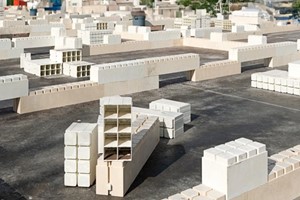Recognizing the pivotal role of building materials in constructing safe and sustainable living spaces is crucial for the construction industry. This imperative has become increasingly apparent through the lens of various relocations undertaken during formative years. It was during a tenure at Enterprise Community Partners, a nonprofit specializing in community development and affordable housing, that the realization of the substantial impact of construction methods and materials on human and planetary health became evident.
The choice of building materials significantly influences both the immediate environment and the broader community. Unlike consumable goods, where ingredient scrutiny is possible through labeling, assessing the composition of a dwelling is not as straightforward. This article underscores the importance of investing in initiatives that eliminate the use of toxic chemicals throughout the housing supply chain. This supply chain extends beyond individual homes, intersecting with educational institutions, offices, healthcare facilities, and places of worship. Opportunities abound to enhance worker health, community well-being, and planetary health by breaking the cycle of pollution inherent in our building supply system.
The prevalence of toxic chemical exposure in the built environment is a pervasive issue affecting all, regardless of location or demographic. A case in point is a pilot study conducted in a certified green building on the Upper West Side of New York City. Wristband monitoring technology revealed the presence of 11 harmful chemicals, including persistent, bioaccumulative, and toxic substances. This study, along with personal experiences, emphasizes the urgent need to address the issue of toxic building materials systematically.
A recent tour of construction projects in North Minneapolis brought to light the far-reaching consequences of materials with harmful ingredients. Pollution generated during the production of such materials does not confine itself to the end product but extends to the communities involved in its manufacturing. Furthermore, the transportation of these materials exposes numerous people and natural spaces to pollutants. The article stresses the importance of moving away from incorporating hazardous byproducts into building materials, citing examples like the utilization of waste fly ash from coal burning in concrete.
Amidst the current discourse on "decarbonization" in the construction industry, it is essential to broaden the scope beyond addressing fossil fuel-burning systems. A comprehensive approach is necessary to investigate how pollutants, including greenhouse gases and plastics derived from fossil fuels, permeate all aspects of the built environment. This examination encompasses various materials, from flooring to commonly used substances such as polyvinyl chloride (PVC) and concrete.
Balancing the imperative to increase the supply of safe and affordable housing with material health considerations is crucial. Neglecting material health in construction projects not only exacerbates planetary and human suffering but also perpetuates carbon emissions, hindering efforts to combat climate change. The accumulation of toxic chemicals in buildings poses additional challenges in the aftermath of extreme weather events, complicating cleanup and reconstruction efforts.
Certain materials wield outsized influence on emissions and pollution impacts. Concrete, aluminum, and steel, for instance, contribute significantly to global emissions and associated health impacts. The U.S. federal government's Buy Clean Initiative, prioritizing low-carbon procurement in categories such as steel, concrete, asphalt, and flat glass, is a step in the right direction. Environmental Product Declarations (EPDs) are utilized to compare products, promoting transparency and informed decision-making in the construction industry.
In conclusion, the construction industry must prioritize the adoption of sustainable and non-toxic building materials. Focusing on material health is not only a responsible choice for the environment but also a strategic one for companies aiming to meet evolving standards and consumer expectations. By embracing initiatives that eliminate toxic materials from the construction supply chain, companies can contribute to the well-being of communities, workers, and the planet while aligning with the growing demand for environmentally conscious practices in the construction sector.
|
Acknowledgement |
|
|
Entity Name |
Arch Daily |
|
URL |
|
|
Author |
Dana Bourland |














